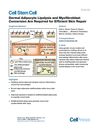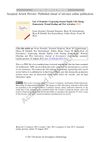37 citations
,
May 2021 in “Frontiers in Cell and Developmental Biology” The study investigated the origins and roles of Ng2+ perivascular cells in mouse skin development and wound healing. It found that Ng2 labeled most perivascular cells in both developing and adult mouse skin, more so than other markers. These cells were categorized into four populations based on Pdgfrα and Pdgfrβ expression. Lineage tracing revealed that Ng2+ cells in embryonic and neonatal skin contributed to various cell types but not interfollicular fibroblasts. Papillary fibroblasts (Lrig1+) gave rise to Ng2+ cells in the upper dermis, while reticular fibroblasts (Dlk1+) were the source in the lower dermis. In adult skin wounds, Ng2+ cells only contributed to blood vessel-associated cells, maintaining perivascular heterogeneity during repair. The study concluded that Ng2+ perivascular cells are a heterogeneous, lineage-restricted population primarily recruited from papillary or reticular fibroblasts during tissue regeneration.
 124 citations
,
June 2020 in “Cell Stem Cell”
124 citations
,
June 2020 in “Cell Stem Cell” Fat cells in the skin help start healing and form important repair cells after injury.
 301 citations
,
February 2019 in “Nature Communications”
301 citations
,
February 2019 in “Nature Communications” The research found that different types of fibroblasts are involved in wound healing and that some blood cells can turn into fat cells during this process.
 145 citations
,
November 2018 in “Nature Communications”
145 citations
,
November 2018 in “Nature Communications” The Sonic hedgehog pathway is crucial for new hair growth during mouse skin healing.
 32 citations
,
August 2015 in “Journal of Investigative Dermatology”
32 citations
,
August 2015 in “Journal of Investigative Dermatology” Prominin-1 expressing cells in the dermal papilla help regulate hair follicle size and communication but don't aid in skin repair.
 120 citations
,
November 2014 in “Biological Reviews”
120 citations
,
November 2014 in “Biological Reviews” The telogen phase of hair growth is active and important for preparing hair follicles for regeneration, not just a resting stage.
1235 citations
,
December 2013 in “Nature” Two fibroblast types shape skin structure and repair differently.
 396 citations
,
May 2011 in “Cell stem cell”
396 citations
,
May 2011 in “Cell stem cell” Nerve signals are crucial for hair follicle stem cells to become skin stem cells and help in wound healing.
338 citations
,
July 2009 in “Development”






